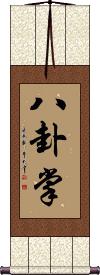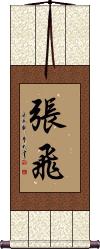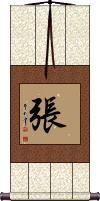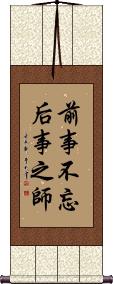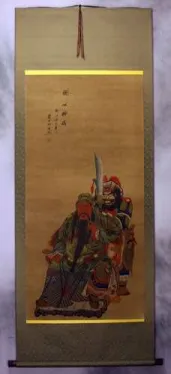Many custom options...
And formats...

Ba Gua Zhang in Chinese / Japanese...
Buy a Ba Gua Zhang calligraphy wall scroll here!
Personalize your custom “Ba Gua Zhang” project by clicking the button next to your favorite “Ba Gua Zhang” title below...
Ba Gua Zhang
Martial arts term
八卦掌 is the title Baguazhang, a form of Chinese boxing.
Literally translated, this means “Eight Trigrams Palm.
You will see this romanized as “Ba Gua Zhang,” or “Pa Kua Chang” (same characters, just different romanization used in mainland China versus Taiwan).
八卦掌 is also known in Japan as hakkeshou or hakkesho.
Zhang Fei
Zhang / Cheung
This is a Chinese surname that romanizes as Zhang, but in Taiwan or old romanization can be Cheung.
This can also be the Japanese surnames Harisaki, Hari, Hara, Tsuan, Chou, Cho, Chiyan, Chiyau, Chan, Chian, Sun, Jin, Jiyon, Jiyan, Zan, San, or Kin.
The meaning of this character can be: to open up; to spread; sheet of paper; classifier for flat objects; sheet; classifier for votes.
Past experience is the teacher for the future
Past events not forgotten serve as teachers for later events.
The most literal translation to English of this ancient 前事不忘后事之师 Chinese proverb is:
“Past events not forgotten serve as teachers for later events.”
However, it's been translated several ways:
Don't forget past events, they can guide you in the future.
Benefit from past experience.
Past experience, if not forgotten, is a guide for the future.
Past calamity is my teacher.
A good memory for the past is a teacher for the future.
The remembrance of the past is the teacher of the future.
If one remembers the lessons of the past; They will serve as a guide to avoid mistakes in the future.
The origin:
This proverb comes from the 5th century B.C., just before the Warring States Period in the territory now known as China.
The head of the State of Jin, Zhi Bo, seized power in a coup. He did this with help from the armies of the State of Han and Wei. Instead of being grateful for the help from Han and Wei, he treacherously took the land of Han and Wei. Never satisfied, Zhi Bo employed the armies of Han and Wei to attack and seize the State of Zhao.
The king of Zhao took advice from his minister Zhang Mengtan and secretly contacted the Han and Wei armies to reverse their plans and attack the army of Zhi Bo instead. The plan was successful, and the State of Zhao was not only saved but was set to become a powerful kingdom in the region.
Zhang Mengtan immediately submitted his resignation to a confused king of Zhao. When asked why, Zhang Mengtan said, “I've done my duty to save my kingdom, but looking back at past experience, I know sovereign kings are never satisfied with the power or land at hand. They will join others and fight for more power and more land. I must learn from past experiences, as those experiences are the teachers of future events.”
The king could not dispute the logic in that statement and accepted Zhang Mengtan's resignation.
For generations, the State of Zhao continued to fight for power and land until finally defeated and decimated by the State of Qin (which led to the birth of the Qin Dynasty in 221 B.C.).
This in-stock artwork might be what you are looking for, and ships right away...
Gallery Price: $108.00
Your Price: $59.88
Not the results for ba gua zhang that you were looking for?
Below are some entries from our dictionary that may match your ba gua zhang search...
| Characters If shown, 2nd row is Simp. Chinese |
Pronunciation Romanization |
Simple Dictionary Definition |
張飛 张飞 see styles |
zhāng fēi zhang1 fei1 chang fei chouhi / chohi ちょうひ |
More info & calligraphy: Zhang Fei(personal name) Chōhi |
八卦掌 see styles |
bā guà zhǎng ba1 gua4 zhang3 pa kua chang hakkeshou / hakkesho はっけしょう |
More info & calligraphy: Ba Gua Zhang{MA} eight trigrams palm; ba gua zhang; pa kua chang |
仉 see styles |
zhǎng zhang3 chang |
surname Zhang |
漳 see styles |
zhāng zhang1 chang |
Zhang river in Fujian |
長 长 see styles |
zhǎng zhang3 chang michi みち |
chief; head; elder; to grow; to develop; to increase; to enhance (1) head; chief; leader; elder; (2) (See 短・1) merit; strong point; (3) superiority; (4) {music} (See 短・2) major; (surname) Michi chang, long; always; zhang, to grow, rising, senior. |
一行 see styles |
yī xíng yi1 xing2 i hsing motoyuki もとゆき |
party; delegation (1) party; group; troop; company; (2) one act; one action; one deed; (personal name) Motoyuki One act (of body, mouth, or mind); holding to one course; devoted. Yixing, A.D. 672-717, a celebrated monk whose secular name was 張遂 Zhang Sui, posthumous title 大慧禪師; he was versed in mathematics and astronomy, a reformer of the Chinese calendar, and author of several works. |
市丈 see styles |
shì zhàng shi4 zhang4 shih chang |
zhang (Chinese unit of length equal to 3⅓ meters) |
張三 张三 see styles |
zhāng sān zhang1 san1 chang san chouzou / chozo ちょうぞう |
Zhang San, name for an unspecified person, first of a series of three: 張三|张三[Zhang1 San1], 李四[Li3 Si4], 王五[Wang2 Wu3] Tom, Dick and Harry; (dialect) wolf (given name) Chōzou |
張丹 张丹 see styles |
zhāng dān zhang1 dan1 chang tan |
Zhang Dan (1985-), Chinese figure skater |
張儀 张仪 see styles |
zhāng yí zhang1 yi2 chang i chougi / chogi ちょうぎ |
Zhang Yi (-309 BC), political strategist of the School of Diplomacy 縱橫家|纵横家[Zong4 heng2 jia1] during the Warring States Period (475-221 BC) (person) Zhang Yi (?-310 BCE) |
張勳 张勋 see styles |
zhāng xūn zhang1 xun1 chang hsün |
Zhang Xun (1854-1923), Qing loyalist general who attempted to restore the abdicated emperor Puyi 溥儀|溥仪[Pu3 yi2] to the throne in the Manchu Restoration of 1917 張勳復辟|张勋复辟[Zhang1 Xun1 Fu4 bi4] |
張寧 张宁 see styles |
zhāng níng zhang1 ning2 chang ning |
Zhang Ning (1975-), PRC female badminton player and Olympic gold medalist |
張寶 张宝 see styles |
zhāng bǎo zhang1 bao3 chang pao |
Zhang Bao (-184), leader of the Yellow Turban rebels during the late Han 漢朝|汉朝[Han4 chao2] |
張岱 张岱 see styles |
zhāng dài zhang1 dai4 chang tai |
Zhang Dai (1597-c. 1684), late Ming scholar |
張怡 张怡 see styles |
zhāng yí zhang1 yi2 chang i |
Zhang Yi (1608-1695), prolific author and poet spanning interregnum between Ming and Qing |
張戎 张戎 see styles |
zhāng róng zhang1 rong2 chang jung |
Jung Chang (1952-), British-Chinese writer, name at birth Zhang Erhong 張二鴻|张二鸿[Zhang1 Er4 hong2], author of Wild Swans 野天鵝|野天鹅[Ye3 Tian1 e2] and Mao: The Unknown Story 毛澤東·鮮為人知的故事|毛泽东·鲜为人知的故事[Mao2 Ze2 dong1 · Xian1 wei2 ren2 zhi1 de5 Gu4 shi5] |
張揖 张揖 see styles |
zhāng yī zhang1 yi1 chang i |
Zhang Yi (c. 3rd century), literary figure from Wei of the Three Kingdoms, other name 稚讓|稚让[Zhi4 rang4], named as compiler of earliest extant Chinese encyclopedia 廣雅|广雅[Guang3 ya3] and several lost works |
張敞 张敞 see styles |
zhāng chǎng zhang1 chang3 chang ch`ang chang chang |
Zhang Chang, official and scholar of the Western Han dynasty |
張斌 张斌 see styles |
zhāng bīn zhang1 bin1 chang pin |
Zhang Bin (1979-), CCTV sports presenter |
張旭 张旭 see styles |
zhāng xù zhang1 xu4 chang hsü |
Zhang Xu (probably early 8th century), Tang dynasty poet and calligrapher, most famous for his grass script 草書|草书 |
張籍 张籍 see styles |
zhāng jí zhang1 ji2 chang chi |
Zhang Ji (767-830), Tang Dynasty poet |
張華 张华 see styles |
zhāng huá zhang1 hua2 chang hua |
Zhang Hua (232-300), Western Jin writer, poet and politician; Zhang Hua (1958-1982), student held up as a martyr after he died saving an old peasant from a septic tank; other Zhang Hua's too numerous to mention |
張融 张融 see styles |
zhāng róng zhang1 rong2 chang jung Chō Yū |
Zhang Rong |
張衡 张衡 see styles |
zhāng héng zhang1 heng2 chang heng choukou / choko ちょうこう |
Zhang Heng (78-139) great Han dynasty astronomer and mathematician (person) Zhang Heng (78-139 CE; Chinese scientist) |
張角 张角 see styles |
zhāng jué zhang1 jue2 chang chüeh choukaku / chokaku ちょうかく |
Zhang Jue (-184), leader of the Yellow turban rebels during the late Han (person) Zhang Jiao (?-184 CE) |
張載 see styles |
chousai / chosai ちょうさい |
(person) Zhang Zai (1020-1077 CE) |
張騫 张骞 see styles |
zhāng qiān zhang1 qian1 chang ch`ien chang chien chouken / choken ちょうけん |
Zhang Qian (-114 BC), Han dynasty explorer of 2nd century BC (personal name) Chōken |
復社 复社 see styles |
fù shè fu4 she4 fu she fukusha ふくしゃ |
Fushe, late Ming political and cultural movement led by Zhang Pu 張溥|张溥[Zhang1 Pu3] and others, advocating the revival of ancient studies (noun/participle) returning to a company where one has worked before |
方丈 see styles |
fāng zhang fang1 zhang5 fang chang houjou / hojo ほうじょう |
square zhang (i.e. unit of area 10 feet square); monastic room 10 feet square; Buddhist or Daoist abbot; abbot's chamber (1) (See 丈・じょう・1) square jō (approx. 10 sq feet); (2) {Buddh} abbot's chamber; (3) chief priest; (p,s,g) Hōjō An abbot, 寺主 head of a monastery; the term is said to arise from the ten-foot cubic dwelling in which 維摩 Vimalakirti lived, but here seems to be no Sanskrit equivalent. |
明史 see styles |
míng shǐ ming2 shi3 ming shih meiji / meji めいじ |
History of the Ming Dynasty, twenty fourth of the 24 dynastic histories 二十四史[Er4 shi2 si4 Shi3], compiled under Zhang Tingyu 張廷玉|张廷玉[Zhang1 Ting2 yu4] in 1739 during the Qing Dynasty, 332 scrolls (personal name) Meiji |
Click here for more ba gua zhang results from our dictionary
The following table may be helpful for those studying Chinese or Japanese...
| Title | Characters | Romaji (Romanized Japanese) | Various forms of Romanized Chinese | |
| Ba Gua Zhang | 八卦掌 | hakkeshou / hakesho | bā guà zhǎng ba1 gua4 zhang3 ba gua zhang baguazhang | pa kua chang pakuachang |
| Zhang Fei | 張飛 张飞 | chou hi / chouhi / cho hi | zhāng fēi zhang1 fei1 zhang fei zhangfei | chang fei changfei |
| Zhang Cheung | 張 张 | chou / cho | zhāng / zhang1 / zhang | chang |
| Past experience is the teacher for the future | 前事不忘后事之師 前事不忘后事之师 | qián shì bú wàng hòu shí zhī shī qian2 shi4 bu2 wang4 hou4 shi2 zhi1 shi1 qian shi bu wang hou shi zhi shi | ch`ien shih pu wang hou shih chih shih chien shih pu wang hou shih chih shih |
|
| In some entries above you will see that characters have different versions above and below a line. In these cases, the characters above the line are Traditional Chinese, while the ones below are Simplified Chinese. | ||||
Successful Chinese Character and Japanese Kanji calligraphy searches within the last few hours...
